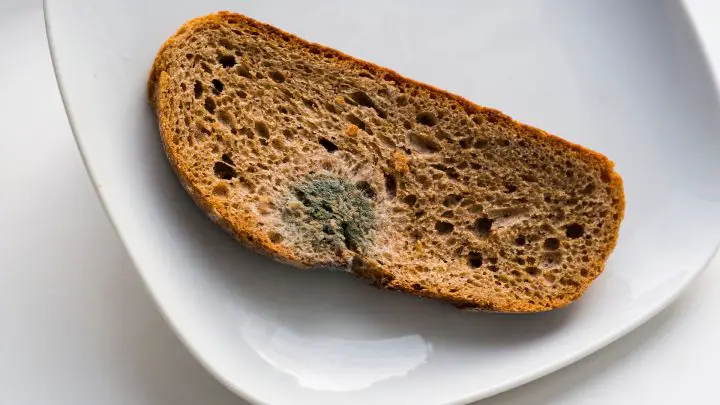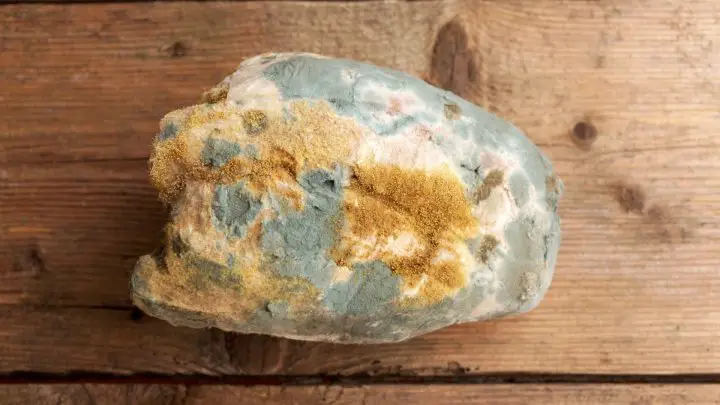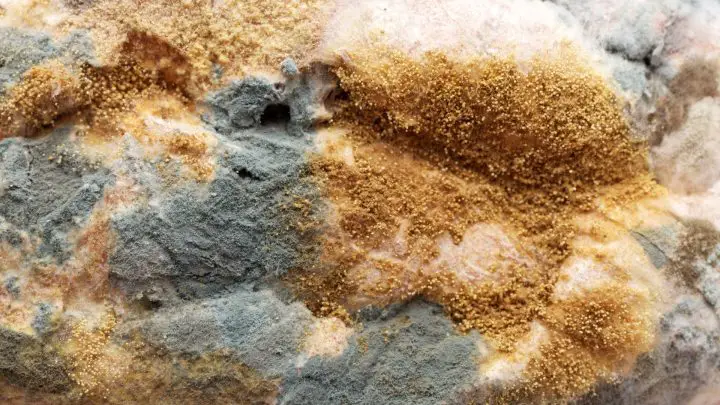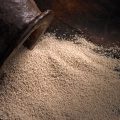Does your sourdough bread have mold growing on it? Mold is a fungal growth that appears and spreads on all sorts of organic matter. There are many different types of mold, each with its own distinctive color, and while mold can be especially displeasing, it’s important to recognize it so that you can avoid it from occurring over and over again! Here are some ways to tell if there is mold on sourdough bread loves of yours.

Table of Contents
- Signs That Sourdough Bread Has Gone Bad
- Mold vs Flour
- Stale vs Spoiled Sourdough Bread
- How to Revive Stale Sourdough Bread?
- How to Prolong the Shelf Life of Sourdough Bread?
- How to Use Stale Sourdough Bread?
- Has Your Sourdough Bread Gone Bad?
- Mold on Sourdough Bread FAQs
Signs That Sourdough Bread Has Gone Bad
We’ve all experienced moldy bread at some point in our lives. Whether it appeared on homemade sourdough bread or store-bought bread, many of us have had the fright and should have disposed of the loaf immediately. If you’re an avid baker, you may have had to discard freshly baked sourdough bread, simply because of the off-putting taste or unpleasant smell.
Some of the common signs that indicate your loaves have gone bad can include:
- Visible mold
- An unpleasant smell
- Bad taste
Visible Mold
If your sourdough bread is beginning to show signs of mold throw it away!
While mold appearing on sourdough bread isn’t entirely unusual, it does take around 5-7 days for it to appear on homemade loaves. Just remember to store the bread at room temperature, and all will remain well.
Do not cut off the moldy portion of the bread. While this may seem acceptable with other kinds of food such as fruit and hard cheese, this is completely unsafe for bread. Mold can easily travel below the surface of the bread; invisible to the naked eye.
Simply put, if one part of the loaf is affected by mold, best believe the rest of the loaf will have suffered as well!
Generally, mold on sourdough bread will be white and fuzzy or greenish-blue.
An Unpleasant Smell
Freshly baked sourdough bread will impart a wonderfully sweet and slightly acidic scent, with tiny hints of yeast. If your sourdough loaf emits a displeasing smell, then it’s time to throw your loaf away!
Bad smells from your loaves can indicate invisible mold growth, especially if your bread has been sitting atop your kitchen counter for more than a week!
Bad Taste
While moldy sourdough bread is one way of detecting if your loaf has passed on, bad-tasting bread can also be a sign. If your sourdough bread tastes odd, it could potentially be a sign of mold growth, and you should dispose of the bread immediately
If you’re dealing with stale bread, however, then you don’t need to throw the whole loaf away in fact stale bread is completely safe to consume, though it can be a tad unpleasant. However, there are many ways to combat the overpowering staleness of your sourdough bread, and one of them includes reviving your loaf. You can find out more about extending the shelf life of sourdough bread with: how long does sourdough bread last?

Mold vs Flour
Bread mold is often white in color, and although that may seem simple enough, it may not always be the case.
Some bread can be topped with a dusting of flour as a final touch. While this can be both appealing and delicious, it can become a tad confusing when trying to distinguish between bread mold and white flour.
Fortunately, you can perform a few tests just to see whether the white spots resting on your bread are either mold or flour.
- Flake it off: Flour will have a powdery texture that’ll flake off once brushed. Albeit, if you’re trying to flake off white mold, it’ll break off in chunks instead.
- Look at the color: While both flour and mold are white, they’re not exactly the same shade. The flour will have a bright appearance, while the mold is a dull off-whitish shade, tinged with green or blue.
- Monitor its growth: If it’s flour, it won’t spread across your loaf. If it is mold, however, it will expand and grow all over your loaf.
- Smell the bread: Simple sourdough bread will smell like nothing unless it’s flavored. If the bread emanates a slightly musty scent, it’s time to throw it away.
Stale vs Spoiled Sourdough Bread
Stale bread is nothing like spoilt bread, in the sense that it is completely edible, though it may need a little reviving before you can start to eat it again.
Staling happens once the starches in the bread begin to dry out and revert into a crystallized state, consequently hardening both the interior and exterior parts of the bread.
When the bread is freshly baked, the starch molecules absorb water and expand, making the bread softer. Though, once the loaf is removed from the oven, the water molecules rapidly dissolve and abandon the starch molecules. This causes the molecules to return to their original state, and stiffen up, meaning that your loaves begin to harden from the moment they’ve left the oven!
How to Revive Stale Sourdough Bread?
Dealing with dry or stale bread? No problem.
Simply wet the bread then place the stale bread on a sheet pan with the right side facing up, or placed it directly on the oven grates.
The water droplets on the bread will generate steam, penetrating the loaf at every angle, effectively restoring its light and fluffy texture, as if it had just been baked!
How to Prolong the Shelf Life of Sourdough Bread?
The simplest way of prolonging the shelf life of your sourdough loaves is by delaying the staling and molding of your bread. Store your sourdough bread in a sealed container and place this in a cool and dry environment to prevent mold growth, and staling.
Before you do this however you’ll need to:
- Wait for your freshly baked sourdough loaf to cool down completely before storing it in its container. This ensures that any excess moisture dissipates, effectively preventing mold growth.
- It’s also important that you wait for your loaf to cool before slicing it. This helps prevent loss of moisture from cutting the loaf too soon, consequently quickening the staling process.
- Under no circumstances should you place your sourdough loaves in the refrigerator. This can cause them to become stale at an incredibly quick pace; much faster than if you were to store bread at room temperature.
- If you wish to preserve the freshness of your sourdough loaves for up to 3 months, simply wrap the loaf in plastic wrap and freeze. Freezing sourdough bread helps prevent mold and stale, however, the quality of the bread will begin to deteriorate after 3 months of freezing, so make sure you use it within this time!
Although a frozen loaf of sourdough bread won’t taste as good as fresh bread, it will taste amazing once prepped appropriately. Take a look at some of the steps to reheat frozen sourdough bread, for that fresh-from-the-oven scrumptiousness!

How to Use Stale Sourdough Bread?
If your sourdough bread has gone stale, don’t fret, there are many ways to fix the problem! You can make a variety of snacks and appetizers, and they’re all absolutely delicious. Your stale sourdough bread can make:
- Bread Crumbs
- French toast
- Croutons
Bread Crumbs
Sourdough bread crumbs are super easy to make, and taste absolutely delicious.
- Toast ½ inch slices of stale sourdough bread in a preheated oven for 15 minutes at 390 degrees Fahrenheit.
- Once the bread has cooled completely, add it to a blender.
- Blend until you’re left with a crumbly powder.
Add this to your salads, and soups for a delightful sourdough bite.
French Toast
If you haven’t tried sourdough French toast yet, then you’re missing out! The incredible combination of sweet and sour makes breakfast worth eating!
- Grab your stale sourdough bread of choice, and slice it into 2-inch thick slices.
- Set your bread aside, and make the eggy mixture. Crack 1 egg into a bowl, and add 1 and a half teaspoons of sugar or 1 tablespoon of honey. Then add ½ a cup of milk (you can also use oat milk for vegan or dairy-free versions). Mix these ingredients, then dunk your sliced bread into the mixture.
- Make sure your bread is fully submerged in the eggy mixture until it’s soaked and dripping.
- Meanwhile, heat a cast iron skillet and spray it with cooking spray.
- Once the skillet is nice and hot, drop your soaked bread into the pan.
- Cook on both sides until it has achieved a wonderful golden brown color.
- Serve with your favorite fruits.

Croutons
Sourdough croutons are another perfect treat to have with soups, salads, and stews. They’re crunchy, tangy, and incredibly irresistible!
- Dice your stale sourdough bread into 1-inch cubes.
- Add a drizzle of oil or melted butter, then season with salt and pepper.
- Spread the diced cubes onto a baking tray and bake in a preheated oven for 10 minutes at 390 degrees F.
- Once they’re crisp and golden, it’s time to indulge!
Has Your Sourdough Bread Gone Bad?
If your bread has signs of mold growth, throw it away! Do not attempt to cut off the part with mold growing on it, in an attempt to salvage what you have. Yes, sourdough bread may be precious, but once it develops mold, unfortunately, it’s game over!
On the other hand, if your sourdough bread is stale, simply revive it with a spritz of water and a quick trip to the oven. Alternatively, you could use your stale sourdough bread and make a bunch of delicious treats!
If you’re looking for mold on your sourdough starter, though, check out my blog where I discuss that matter specifically!
Mold on Sourdough Bread FAQs
Is There Mold on Sourdough Bread?
While sourdough bread can resist mold growth thanks to the good bacteria, it can grow mold once it has remained on your kitchen counter longer than necessary.
What Does Mold Look Like on Sourdough Bread?
The mold on sourdough bread can be white in color, or a slight green with a bluish tinge.
Why Did My Sourdough Bread Mold?
Mold often occurs due to neglect, cross-contamination with other food, or weakened yeasts from forgotten feedings.
Does Sourdough Mold Quickly?
The natural yeasts in sourdough bread primarily resist mold growth, however, this does not mean that sourdough loaves are entirely exempt from mold development. For homemade sourdough loaves, mold usually appears after 5-7 days of storing the bread at room temperature.





![What Soup Goes Well With Sourdough Bread [15 Best Soups To Try] 9 What soup goes well with sourdough bread [15 best soups to try]](https://www.mydailysourdoughbread.com/wp-content/uploads/2023/06/soups-with-sourdough-120x120.jpg)
